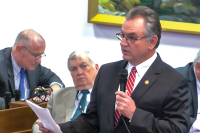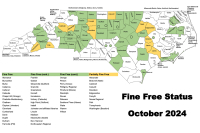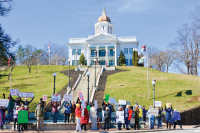WNC artist visits Cuba in search of its political and cultural meaning in the 21st century

It’s about 855 miles between the quiet mountain town of Waynesville, North Carolina and the urban hustle and bustle of Havana, Cuba.
SEE ALSO:
• An Artist’s Visit to Cuba
• Discussion to focus on Cuba
And yet, when painter Christopher Holt opens up his portfolio one recent morning at Panacea Coffeehouse in the Frog Level district of Waynesville, that distance gets a lot shorter. One-by-one, Holt leafs through dozens of his watercolor and oil paintings, all of which depict the vibrant sounds, scents and sights of the foreign country. The island nation and its people flood his thoughts and words when speaking at length over his recent trip there.
Born in Asheville and raised in Waynesville, Holt has traversed the globe, in search of not only himself — as an artist and as a human being — but also in hopes of telling the story of mankind. It’s a visual tale, with brush and a blank canvas, which connects the dots of different people, landscapes, cultures, and ways of life.
His travels have taken him to Cairo, Egypt, last year to paint the city and its history, and Tahrir Square, which was ground zero of the Egyptian Revolution in 2011 during the Arab Spring uprising in the Middle East. And next year, he’ll be heading to Jerusalem to paint a “Good Samaritan” fresco for the Order of St. John humanitarian aid effort in the war-torn country.
But, this year — this past March — Holt jumped on an airplane in Miami and headed 228 miles over the Straits of Florida to Havana. Although the country itself has been off-limits for Americans since the United States government placed a trade and travel embargo on Cuba in 1962 (due to the country falling under communist reign with the revolution led by Fidel Castro and Che Guevara in 1959), the two nations are now beginning to thaw what are some of the last vestiges of Cold War relations.
Related Items
Amid the loosening of the embargos and recent visits from President Obama and The Rolling Stones, the third world country is poised to find itself at the political and economic table of the 21st century, especially in terms of global trade and cultural exchange. And at the center of this next chapter in the history of Cuba comes the endless curiosity and bond of friendship emerging between both sides of the American/Cuban relationship, with Holt having a front row seat on the interaction, one that is seen and felt through his works of art.
Smoky Mountain News: You’ve done other trips similar to this, where you’re traveling and sketching a landscape and its people. Where did the interest in Cuba come about?
Christopher Holt: Well, as it was kind of warming to the possibility of having the Americans having the ability to go, as soon as that started happening, I got interested in going as soon as possible.
SMN: Were you familiar with the culture at all beforehand?
CH: Through the Cuban music and their art, and also Jon Lee Anderson’s biography “Che Guevara: A Revolutionary Life.”
SMN: From my perspective, it must be one of those places that the landscape is just as colorful as the people and the culture?
CH: It’s true. And the Cubans have a high regard for art. There is a lot of street painting. One of the things I ran into — which was right on the Paseo del Prado, the central walking street in the heart of Havana — was that they had free art classes every Saturday and Sunday. It’s free for the public. They set up artists of all sorts — painters, sculptors — and everyone is there making things. You sign up, pull up a chair, and create. Even during the beginning of the reign of the Castro brothers they put a lot of emphasis on the arts and the culture.
SMN: What was it like being an artist walking around there?
CH: Well, besides the regard given to artists, the Cubans also love Americans. For people living in Cuba, the “American Dream” is very much alive. For those Cubans that made it off the island, they’re succeeding far beyond what’s capable for a regular citizen on the island.
SMN: Did that put things in perspective for you, seeing as many Americans feel jaded towards the “American Dream” these days?
CH: If you take a global perspective, you see that the “American Dream” is very much alive. It definitely has its pitfalls and terrible daily stories coming at you. But, whether you’re in Cairo or Havana or wherever, the daily struggle people go through in those countries far surpasses what most people go through in America. I’m not saying we don’t have our struggling class, because we sure do. People of the world are all kind of together, and then there are the plays and movements of the governments worldwide that are separate from what the struggle is — it doesn’t matter where you are.
SMN: Did you have a plan of action before you arrived in Cuba?
CH: I wanted to be in Havana and spend a good time there seeing what I could. And I really wanted to, and did, go to the Vuelta regions of the Pinar del Rio, which is the one of the great tobacco growing regions of the world. My grandparents and great-grandparents were tobacco farmers here in Haywood County. I had a desire to see that down there, and it takes place there today just like it was 50 years ago here. There’s a big ox pulling a plow and it’s all small farmers. There are some big plantations, but, for the most part, some of the world’s greatest tobacco is produced one small farm at a time.
SMN: It’s like a whole new world right in front of you with a blank canvas to paint on.
CH: That’s right. Exactly. That’s what traveling is all about. So, The Rolling Stones just came on (“Beast of Burden” plays overhead in the coffeehouse). The Stones came and played the free show in Cuba the week I arrived. And that was incredible. For me, in America, I’ve seen big concerts and I’ve seen The Stones in the States. But, for the Cubans to see this huge rock show, with the big screens and the whole stage setup was amazing because they’d never seen something like that. Over a half-million people were at that show. And when “You Can’t Always Get What You Want” came on it was chillingly surreal — I thought, “This is Cuba.”
SMN: So, when you set up and paint, what were you looking for, or were things finding you?
CH: I came prepared. I have all my materials with me. And when traveling, you meet people. In the Vuelta, I told the Airbnb there that I was an artist coming to Cuba to paint. And they introduced me to a local artist and guide, who is also a photographer, named Francisco. This guy spoke a little bit of English. He had a great eye as a photographer, and had little resources to create his art. My friend Wyman (Tannehill, a Waynesville native, childhood friend of Holt, and photographer) was able to get him a digital camera. I mean, talk about someone moved to tears. I had already met Francisco, and messaged Wyman before he met me down in Cuba to bring a digital camera for him. Francisco was using an old Fuji camera.
SMN: What was Francisco telling you about being an artist growing up in that space?
CH: That everyday life is a struggle. It’s one thing to try and make it as a Cuban in general; it’s another thing to try and make it as a Cuban artist. One time the actor Ed Harris came to Cuba and Francisco met him. Ed ended up sending him some oil paint. And Francisco still has that tube of paint, unused, because it was so precious and hard to find. The access to materials and abilities to find things to use and to create is very difficult. I asked Francisco if we could get to a spot to overlook the valleys, and he said yes. We set off before sunrise, climbing this mountain in the jungle, in the dark, carrying all of my materials, sweating completely through my clothes. Got to the top as the sun rose.
-
 Title
Title
Title
Title
-
 Title
Title
Title
Title
-
 Title
Title
Title
Title
-
 Title
Title
Title
Title
-
 Title
Title
Title
Title
-
 Title
Title
Title
Title
-
 Title
Title
Title
Title
-
 Title
Title
Title
Title
-
 Title
Title
Title
Title
-
 Title
Title
Title
Title
-
 Title
Title
Title
Title
-
 Title
Title
Title
Title
-
 Title
Title
Title
Title
-
 Title
Title
Title
Title
-
 Title
Title
Title
Title
-
 Title
Title
Title
Title
-
 Title
Title
Title
Title
-
 Title
Title
Title
Title
-
 Title
Title
Title
Title
-
 Title
Title
Title
Title
-
 Title
Title
Title
Title
-
 Title
Title
Title
Title
-
 Title
Title
Title
Title
-
 Title
Title
Title
Title
-
 Title
Title
Title
Title
-
 Title
Title
Title
Title
-
 Title
Title
Title
Title
https://smokymountainnews.com/archives/item/18092-wnc-artist-visits-cuba-in-search-of-its-political-and-cultural-meaning-in-the-21st-century#sigProIdc7168252ef
SMN: What’s going through your head right now during all of this?
CH: That this is why I do what I do. Being an artist, and painting life, people when they see you appreciating their place, it doesn’t matter where you are, they respect that and they feel a bit of pride just that you are looking upon where they live with respect.
SMN: How much does the clock and “time” play into life down there?
CH: Well, you’ll have people in the valleys getting up at 4 a.m. and riding their horse across the valley to get to work. Then, you have Havana, which is live action all hours of the day. It never stops in the city. In places like Havana, you’re living room is not in your house, it’s on the street. There’s always something going on, always somebody coming and going.
SMN: I like your style of painting, where not one line is wasted, and yet not one line is missing. And you’ve mentioned before of an Eastern influence on your work, where I look at your paintings and see this kind of like visual haiku aspect to the pieces.
CH: You know, I really appreciate that kind of observation. I do have kind of a minimalist approach. Not a line wasted, that’s what we all strive for, in any form of art. Watercolors especially lend themselves to that kind of movement. With watercolor, I like that I can get things down quickly, I can capture a more synched moment in real time, where with oil painting, you have to spend hours or days dedicated to a spot. And when you’re traveling, you have to figure out the best way to use your time with what you want to create. My travel style has led me to do the watercolors, take the watercolors back to my studio, and work from there into larger oil paintings or other art forms.
SMN: What’s going on around you when you’re working on the streets?
CH: The ones on the street, sometimes I have 10 kids leaning over my shoulders for hours, kids with popsicles, and like anywhere else, they like seeing the art going down, happening in front of them. I’m talking while I’m working. I’m getting to know them. I’ll give them a dollar to get a couple sodas because it’s so hot down there. I might be in one spot for three days, and the same people come by, they tell me about their lives, their street corner of the city that’s their home.
SMN: What’s the scene of the first painting?
CH: The first place was Cojimar, the fishing village where Ernest Hemingway was inspired to write “The Old Man and The Sea.” President Obama had just left Cuba, The Stones were just arriving, Havana was packed, so I headed to Cojimar. I went out and painted this Spanish fortress, and they had all these fisherman pulled together there.
SMN: What was the last painting?
CH: This watercolor of the Prado, looking straight down it to the capital building.
SMN: Have you noticed any change in yourself?
CH: Well, when I was in Cairo for five weeks last year, three years or so after the Arab Spring uprising in Tahrir Square, and there I was doing a watercolor in the square with not a soul around. It was almost like that revolution had been swept under the rug. What was interesting to me, after being in Cuba, was it is like the revolution happened yesterday, where the revolution was as present today as it was over 50 years ago when Fidel and Che rode into Havana. You walk down the streets in Havana, and you might have this nice hotel here, then next door is a family home, where the windows are falling apart, and there’s a black and white television playing a documentary about the revolution on one of the two channels in the country. The propaganda is all still there, and it was something that kept getting my attention — the isolated bubble of the country, the frozenness of where it still stands today.
SMN: What do you think about the warming of relations between the United States and Cuba, and what that might mean to the fate of Cuban culture?
CH: Well, for one, we have a lot to learn about each other. I don’t think Americans will ruin Cuba. With every first world country, you have to take some good with the bad. But, with our arrival and care and investment in that country, it’s needed. They need what we have. They need money. They need interest in their country. They need modern medicine. And we could use some of their culture, the idea of utilizing what we have without the need for excess. Their idea of community, their reliance upon their neighbors is a way of life.
SMN: It’s funny you say all of that, because you could easily apply that community love and preservation of culture to Western North Carolina and greater Southern Appalachia, where you have a place very isolated from the rest of the United States that came into modernity with the creation of the national park and the interstate.
CH: Yes. Especially going to the tobacco country. I went to this farm and met this guy Nana. A total jokester. He ends up offering a drink of rum. I end up spending two days on his farm, helping put up the tobacco. It was a full circle type of thing, just like being on a tobacco farm in Haywood County and sharing a drink of moonshine.
SMN: What do you see in your paintings in hindsight, now that you’re back in the States?
CH: It’s so hard to capture everything, but the story in the paintings, in Cuba — it’s the people. All of those people I met. Watching Nana meticulously going up and down the rows of the tobacco field, checking everything, where that piece of dirt is his entire life. Those experiences just make me want to tell the story of the world even more. And the story is, is that we’re all related here on Earth, we’re all one big family. In this country right now, in the United States, we can all use the reminder that we’re all brothers and sisters — love and friendship is truly the only way to get by in this world.









